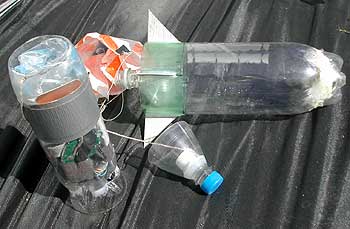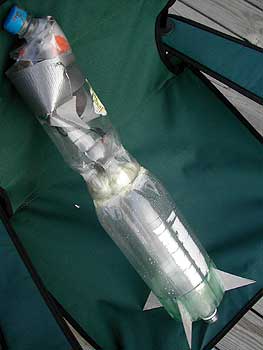
Launch of the newly improved 2-liter powered water rocket cam has been delayed due to inclement weather the past week. I have a good feeling about today. The one caveat is that we need a big, open field on the off chance that the parachute actually deploys this time.

Let me briefly describe our launch vehicle.
Built using the same modular construction techniques seen in earlier prototypes this model sports a larger, more powerful two-liter propulsion module. In order to mate with the 1-liter wireless cam module the end of another 1-liter bottle was attached to the two-liter bottle. It looks a little messy because I'm experimenting with the dreaded, but useful, triple expanding insulation foam as a glue substrate. It worked on my electric car and dog it should be fine here.
The other change is in the rocket nose cone. There is a small water reservoir in the tip to help with deployment. Taking Kirk's advice I also trimmed the cone down so it barely sits on the top of the cam module and has no chance of getting stuck. This might also be a bad thing, since it may choose to not-be-stuck during the high speed ascent, ripping the parachute to shreds and guaranteeing yet another lawn dart landing.
Electronics have all been re-soldered, battery replaced, and another airbag stuffed into the cam module "just in case."
I also messed with the camera a bit and tried to improve the focus. A 12volt gel cell has been put into service to power the receiver so the whole production is now highly mobile. Cross your fingers.
UPDATE: Technical difficulties ruled the day. While the wind was mostly calm there really wasn't much to worry about, since the rocket never got high enough to drift away. First off the camera quit working, I'm thinking the receiver is messed up. So we pulled the 9v battery out and had some test shots to check out the parachute. Early deployment. In fact on every test shot (4 or 5?) it would go up about forty feet and *floop* the parachute pops out! I may have trimmed too much from the nose cone and the camera module opening is pretty warped.
On the other hand my new liter-sleeve rocket worked great! Brian went so far as to steal Zeke's tennis ball and put it inside, between the 20oz and the 1-litter sleeve. Much to Zeke's amazement, I'm sure, his tennis ball flew over a hundred feet straight up. Landing was a straight dart shot back into the earth. The tennis ball caused a cool bounce-back on landing and the inner bottle was shot back skyward.
Update to the update: came up with a simple collar mechanism (staples) which seemed to keep the cone from wiggling, at least in my ground based low-G tests. The G forces of take off laugh at my simple mindedness! Bwwaaahaaahaaa!!!!
Two attempts (battery out) and each one still deployed early, maybe even earlier than before. Most frustrating. Since I was doing all of this by myself I used little strips of duct tape to hold the cone on while I filled the rocket with water and positioned it. On the third shot I purposely failed to take them off. Since they fell off with the slightest provocation I figured they wouldn't make it past takeoff.
Wrong!
A beautiful launch, straight up and straight back down, with me standing there swearing and praying, neither of which budged the parachute or lessened the impact.

BTW, I tested the wireless camera gear this evening and everything worked like a charm. It's a conspiracy. Or maybe a sign.
...oh THAT explains it...
My log files show consistently heavy traffic for an article I posted last year about installing pergo prodigy. On closer inspection I found that it is now the number one search result, even above the manufacturer's site.

From a 4th of July hike in the pucker brush of New Hamphsire Faith poses for a comparitive study in footprints.
See if you can spot all five "wild animals": atv, deer, dear, dog, and moose.
And, ...., and what happened?
I've updated the entry, as you've probably noticed by now.
A little "lip" on the top bottle to keep the nose cone centered might do it. Probably need to make a new camera module at some point. I have been using a little heat gun to mold the edges and you can never really control what the plastic is doing when heaterd so it does all kinds of uncontrolled things.
As to my electronic parachute system:
I bought one of those little wireless cars from walmart and it has a dinky little wireless rcvr, battery, motor module, about the The motors are high speed, low torque so either I'll need some serious gearing or pop the motors out and make some kind of solenoid. And of course the range is limited, so a better antenna, blah, blah, blah....
When things start getting the complicated it's time to back up and try a simpler approach.
Ideas?
you should try one of those model rockets because I have one that ejects satellites. if you have a nearby hobby store look in the rocket section.trust me!!!!!!!